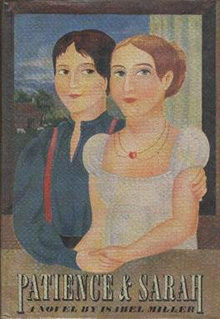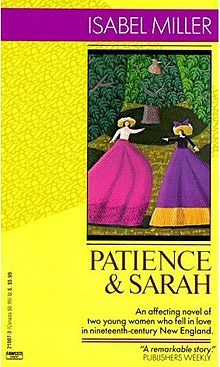 Patience and Sarah
Patience and Sarah
by Isabel Miller
Published by McGraw-Hill
Published 1972
Originally published in 1969 as A Place For Us
Romance (lesbian)
215 pgs. • Find on Amazon.com
Reviewed by Stephen O. Murray
January 21, 2004
Patience and Sarah by Isabel Miller[1]Miller was born Alma Routsong on November 26, 1924, in Traverse City, Michigan. She began college in 1942 and received an honors B.A. in art from Michigan State University in 1949. In between those … Continue reading is a classic of woman-identified fiction in general and lesbian historical fiction in particular. It was completed in 1967, before the dawn of lesbian feminism, and self-published two years later with the title A Place For Us in an edition of one thousand copies. The “Bleeker Street” imprint book was first sold on Greenwich Village street corners and at meetings of the New York chapter of the Daughters of Bilitis, the pioneer (preliberation) lesbian organization. It received the American Library Association’s first annual Gay Book Award in 1971, and, under the title Patience and Sarah, the book was published by a mainstream press (McGraw-Hill) in 1972 and has been reprinted several times since then.
The novel is a saga of a Connecticut girl raised to do a man’s work (Sarah), who attracted a very proper young lady and “folk painter,” whose father had provided for her (Patience). Sarah’s father repeatedly beats her for trying to go to Patience, but accedes to her going off to farm in Gennesee County New York. After adventures on the road that lasted the whole summer, traveling around (and learning to read) from an itinerant book-seller (and author) who wintered in Manhattan, Sarah returned and began visiting Patience every day.
After Sarah’s sister-in-law walks in on them with their bodices open, kissing in bed, she hurls the first chapter of St. Paul’s Epistle to the Romans at Patience, and Sarah’s brother sadly tells Patience to cease her sinful carrying-on or leave. He buys out her share of the house and land she inherited from their father and leaves for New York City, where she and Sarah visit the book peddler at his winter home. Because the Erie Canal was making land near it costlier, the women settle in Greene County, fix up a log cabin, and live happily ever after together.
 The novel alternates narrators. It is an easily digestible, modest historical romance of women determined to make their own life, constrained by the expectations of others, but establishing an isolation-à-deux paradise out in the country (similar to the greenwoods beckoning at the end of E. M. Forster’s Maurice). The book was written during a time of romanticizing rural communes, but also at a time when the characters in lesbian fiction did not meet happy endings.
The novel alternates narrators. It is an easily digestible, modest historical romance of women determined to make their own life, constrained by the expectations of others, but establishing an isolation-à-deux paradise out in the country (similar to the greenwoods beckoning at the end of E. M. Forster’s Maurice). The book was written during a time of romanticizing rural communes, but also at a time when the characters in lesbian fiction did not meet happy endings.
The relationship portrayed is also quite butch/femme role-dichotomized, before the radical lesbian egalitarian ideology of the 1970s condemned such roles, and the sex is not graphic—or even clear about whether the public butch/femme roles carried over to between the sheets. (There weren’t any streets there and then…)
The title characters were inspired by the example of the folk artist painter Mary Ann Willson and her companion, Miss Brundadge, who lived in Greene County, New York, during the 1820s and ’30s. Willson seemingly stopped painting upon Brundage’s death. Before the search for female artists propelled by second-wave feminism began, Miller’s work had bee rediscovered in 1943 and her Prodigal Son watercolor series is now in the collection of the National Gallery of Art in Washington, D.C.
First published by epinions, 21 January 2004
©2004, 2017, Stephen O. Murray

